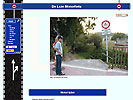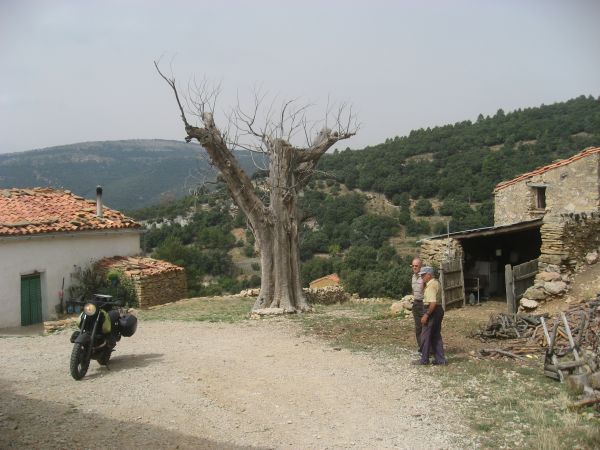
Spain is motorcycle rider's heaven. There are almost as many mountain ranges as towns, and they are all different.
Spain is different from the rest of Europe: while Europe is green, Spain is red.
Literally red: there is no other place within Europe where you see so many bare rock, and bare rocks are often red and orange and yellow.
Spain is also: delicious food and whine, cities with old castles, monasteries ans churches, reminiscences of Celts, Romans, Moorish kings and architects, and catholic rulers, proud people who are very Spanish in the eyes of outsiders, and who are completely different from the Spaniards in the next village, according to themselves.
![]() Er is een Nederlandse versie:
Er is een Nederlandse versie:
http://www.luiemotorfiets.nl/reizen/spanje/
The language
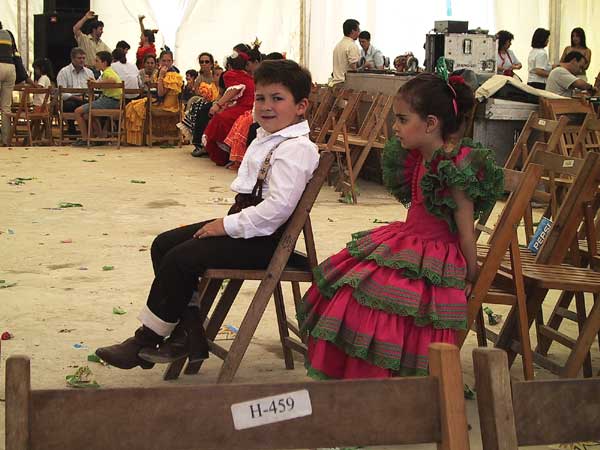
Spanish
Before entering Spain, you will have to learn some Spanish. Even in the bigger cities like Barcelona or Valencia, a small minority of the people speak English (or any other foreign language).
In expensive hotels, the receptionist will probably speak English, but for everything else, you'd better understand and speak at least a few words (though people are learning English now everywhere in Spain: this information might be outdated within a couple of years!).
Spanish people are very polite, and they like to talk. When you ask them something in a language they don't understand, they don't know how to react, and it will be almost impossible to create contact.
When you know just a few words, contact will be much easier.
Pronounciation
Spanish pronounciation is fairly simple. Vowels are pronounced the same, no matter between which other vowels or consonants they are placed.
Some consonants are pronounced in another way than most of us are used to:
the h is not pronounced at all,
the j is pronounced as a guttural sound,
the v is pronounced somewhere between a v and a b,
the c before an a, e or i is pronounced as the English th in this,
and in Spanish, the s is never seen at the start of a word when it is followed by another consonant (therefore, Spain is called España).
There are many sites allowing you to train your Spanish pronouciation skills, like this Spanish pronounciation tutorial,
Language
You should at least learn how to ask for a room, or a place for a tent in Spanish.
A language guide and especially a guide with translations of what can be found on a Spanish menu, are compulsary items for anyone visiting Spain.
Spanish Language Links
The BBC has several courses in Spanish, both off- and online, both free and for sale.
Wikipedia has a page about the Spanish language, which is thorough and interesting.
Traffic rules
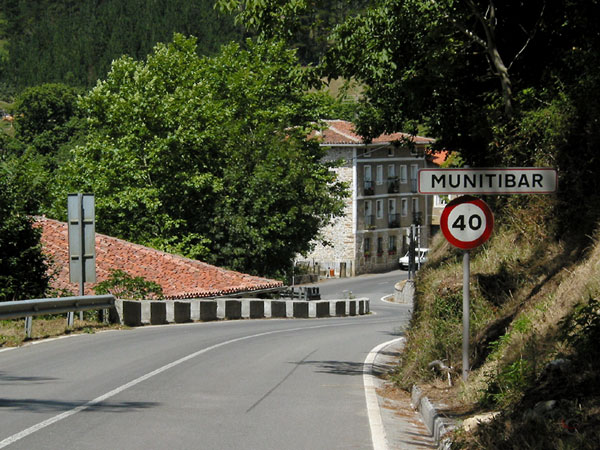
Maximum speed
Without signs stating otherwise, maximum speed is:
- 50 km/h in urban spaces,
- outside urban spaces and outside motorways: 90 km/h or as signed, may vary between 60 and 100 km/h,
- On autovia's (dual carriage ways) 80-140 km/h (as signed), and
- 120 km/h on autopista's (motorways).
Alcohol
The maximum promillage is 0.05 (which is about two glasses of wine or beer).
In bars and restaurants, you often see bottles and glasses that are still half full. The Spanish like to drink, but many of them are capable of drinking moderately.
Try to be very honest to yourself when deciding whether you can do the same, or whether you'd better stay off alcohol completely before riding.
Reflective vest
The Spanish law says that you should have a reflective vest with your luggage, to use in case of an emergency (to prevent behing hit by a car).
We always forgot, and never got into trouble without it, but it might be a good idea to carry it: it's advisable to wear such a vest in case of an accident or other emergency!.
Children
In principle, you may not have children under the age of 12 as a passenger on your motorcycle. It is possible to get permission to do so, but I don't know the details: if you are planning to take a younger child along, contact the "Officina Española de Turismo" in your country.
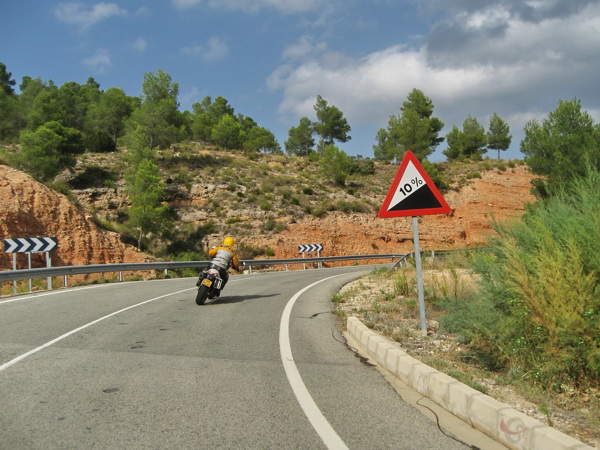
Right of way
In Spain, traffic coming from the left should yield to traffic coming from the right, unless signs tell otherwise.
"Ceda el Paso" means you should yield: traffic on the other road has the right of way.
A yellow triangular sign with a red border means the same (in most cases, there will be the words "Ceda el Paso" as well).
Roundabout
Traffic on the roundabout has the right of way. When approaching a roundabout, you should thus yield to traffic coming from the left.
Light
Motorcyclists should have their headlights on.
Helmet
Every motorcycle rider should wear a helmet in Spain.
Links
The site of the Spanish AAA is RACE, the Real Automovil club de España.
Traffic culture

Towns and Villages
In Spain, the main road will often lead you through villages and small towns. Most Spanish drivers keep their speed low (below 50km/h), so these villages and towns stay livable.
So, the habit is to really keep your speed low in villages and towns.
Walking
During any time of day, but especially between 6 and 9 (paseo time), you will meet people walking, sometimes even along the motorway, en sometimes far from any village or house.
Again, try to be considerate towards pedestrians.
Animals
Everywhere in Spain (motorways being the exception), you may meet animals on the road. Mules and donkeys are still used for transport (though rarer and rarer). And beware of stray cows, and sometimes horses, in rural areas.
Flocks of sheep and goats are less rare. You will see them often beside the road, and from time to time they will cross the road.
Traffic: Congestion
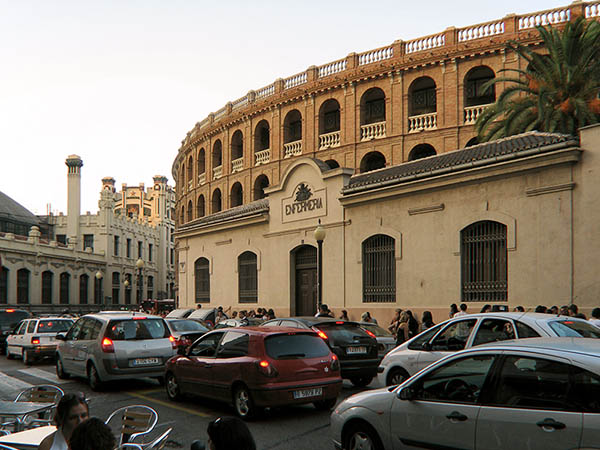
Empty
Most of Spain's area is empty. Spain is one of the most sparsely inhabited countries of Europe.
There are villages that are almost completely deserted.
So, when traveling outside cities, you will seldomly ride in dense traffic.
Big cities
Inside the big cities, Madrid, Barcelona and Valencia, it's a different story.
Traffic is very dense, with trucks, cars, motorcycle and (especially) scooters everywhere.
One way streets
Especially the old inner cities are often based on the streetplan from the Middle Ages or even before, with tiny alleys, curved, and sloping. Sloping streets often have the form of stairs.
As a result, inner cities often are a maze of one-way streets: difficult to find your way, and desorientating because no single street runs in a straight line.
In most cities there are some areas only for pedestrian, but in general, you may ride everywhere if you think it's possible.
In Sevilla for example, one-way streets are almost entirely absent. When two cars approach each other in a street which is too narrow for two cars alongside, they simply have to decide which of them reverses to make way for the other.
At what time do people eat in Spain?
Breakfast
A Spanish breakfast is rather poor compared to an English or American one: a cup of coffee and a tostada (toast) or bolleria (a sweet croissant), and that's it.
An alternative is to try churros (fat and sweet) con chocolate (hot chocolate, almost as molten chocolate).
Most bars can serve you such a breakfast, on any time in the morning.
There is a second breakfast around 11 a.m. (again, a coffee and a bolleria).
Lunch
Lunch is the main meal of the day, and it is eaten rather late: from about 2 p.m. until 4 p.m.
During weekends, the Spanish love to drive into the country, and have their meal in a beautifull spot, somewhere in the mountains or in a village or city that is attractive.
Many of these places are not only known for their (natural or man-made) beauty, but also for the culinary specialties they offer.
Segovia, for instance, is known for its roasted piglets (very young suckling pigs) or goats (the same), and Morella (situated on a hill-top) is known for its hams.
Dinner
Dinner is served late. In the south, from 10 p.m., and in the north from about 9.30 p.m.
Instead of dinner, you can also fill your stomach with tapas (which are served almost all day long): you will probably not be very hungry after your lunch.
For us motorcycle riders, having dinner at the Spanish dinnertime is ideal:
You can ride on until it's time to find a place to sleep, and then there will be plenty of time to find a place to eat.
Where and what to eat?
Restaurants
Restaurants come in different names. Some ar simply called restaurants. Asadores have roasted meat as a specialty. A Casa de Comidas (literally: house of meals) is a cheap restaurant for truck drivers or road workers. There are plenty of them, and they offer excellent inexpensive meals.
Bars and Cafe's often have a "comedor", a room for meals.
If you ask for "comer" in a bar, they will think that you mean to ask whether or not they have a comedor. You might end up having no as an answer, while everyone around you is happily eating delicious tapas!
The comedor is for "comer", for eating a meal. Tapas are bar food, and if you just want some tapas, ask for tapas or raciones.
Culinary tourism
One of the attractions of Spain is that the Spanish tend to enjoy their holidays in Spain itself, and that eating is one of the main ingredients.
As a result, you will find restaurants everywhere: when there is a beautiful signposted walk into the mountains, you will find a restaurant on the top; when you walk to the lonely lighthouse of Cap de Creus, you will find a restaurant; when you visit a small village with a beautifull Plaza Mayor such as Chinchon, it will be filled with restaurants.
Bars
When you don't want a whole meal, you can enter any bar, and ask for tapas, raciones (tapas in a bigger quantity), or bocadillos (sandwiches).
The ease to eat very well in such a variation of places, is one of Spains many attractive aspects.
Specialties
Every region has its specialties. Ham (jamon iberico) from Extremadura, roasted pig sucklings from Segovia, paella from Valencia, gazpacho (cold cucumber and tomatoe soup) from Andalucia, etc etc.
The advice is: try everything, and take a menu reader along to figure out what is mentioned on the menu.
In some of the cheaper restaurants, there is no menu: the waiter comes at your table, and mumbles todays choices in rapid Spanish. You will be glad if you took the effort to study some food words in Spanish before!
What to drink?
Water, wine and beer
Spain is a wine producing country: every restaurant or bar serves local wines, and many of them are very good.
In many restaurants, you will be served water as well, without having to ask. If they don't, ask for it. You can always ask for a big bottle (grande botalla): it isn't expensive.
When you look around in a restaurant, you will see bottles of wine and water on every table. The Spanish not only share their food (tapas and raciones are often used "a compar", to share), but also their drinks.
Meals are most often accompanied by wine and water, but in between meals, the Spanish love beer as well. It is cheap, and available everywhere.
Horchata
Horchata is a specialty from Valencia. When you come accross it, try it!
It is made from "chufa", roots from a certain plant, tasting a bit like almonds. It is used to make a milky substance which is drunk cold.
Zumo de Naranja
Another specialty of Spain are its oranges, "naranjas", again, especially around Valencia.
You will be able to taste fresh orange juice everywhere. Just ask for "Zumo de Naranja".
Where to stay?
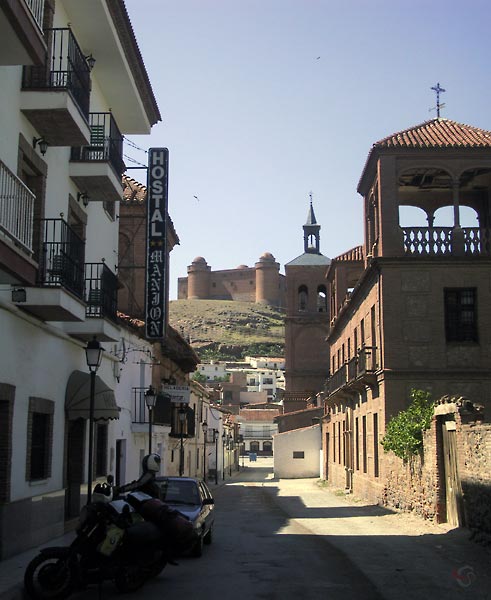
Campings
I have never heard of any motorcycle-only campings in Spain, but of course, you don't need motorcycle-only campings to find a spot for your tent and your bike.
The more inland you go, the fewer the camping sites that you will encounter. They are mainly situated alongside the coast and in the Pyrenees.
If you are looking for a spot near Bilbao, I can highly recommend Camping Arrien in Gorliz.
Hotels and Hostals
A "hostal" is something else than a "hostel"!
What is called a hostel in English speaking countries, is known as an "Alberguo" in Spain.
A "Hostal" is a simple and cheap hotel, often above a bar, like the one on the photograph.
Hostals are a very good choice for motorcycle riders: they are numerous, they are cheap, often there is a bar where you can have your meal on the evening that you arrive, and where you can have your breakfast the following morning.
You will rarely find a hostal with English speaking owners: you should be able to ask for a room ("habitacion") in Spanish.
There are hotels in all price classes as well. Paradores are very luxurious hotels, often in buildings with a history: castles, monasteries.
It is special to sleep in such a place, but you will find far more "Spanishness" in a simple hostal.
Tourist Information
Booking.com for Spain offers information on accomodation with the possibility to book in advance.
We also have a page about the places to sleep in Spain we especially liked.
Motorcycle roads: Spanish mountain ranges

Pyrenees
When you reach Spain by land, the Pyrenees will be the first mountain range that you will see. A splendid mountain range!
It is possible to cross the Pyrenees from west to east or the other way around. You will have to descend to the south and climb towards the north many times, and you can often choose between a bigger road which is lower, or a higher smaller road.
In many places, there are unpaved roads as well. Mind people on foot, and flocks of sheep: those roads are multi-purpose, and as long as nobody has anything to complain, motorcycle riders may keep using those roads.
Picos de Europa
The second mountain range that springs to mind is formed by the
Picos de Europa
.
The Picos are beautiful, rugged, and... green (which means it rains more often than in the rest of Spain).
You can reach high viewpoints offering great panoramas using paved roads, and there are unpaved roads to explore as well.
Sierra Nevada
The Sierra Nevada, to the east of Granada in the south, have the highest mountain pass of Europe, unfortunately prohibited for motorized vehicles.
The Alpujarras, shown in this picture, are lower, and reside on the southern side of the Sierra Nevada.
More mountains
Spain has numerous mountain ranges. When you look at the map you start wondering why each has its own name, but when you ride through them: you see why.
Each mountain range has its own characteristics, its own colours, its own vegetation.
Ronda is in the centre of several very beautiful mountain ranges. To the north east of Valencia, you can spend weeks exploring the mountains as well.
Motorcycle roads: how to find them
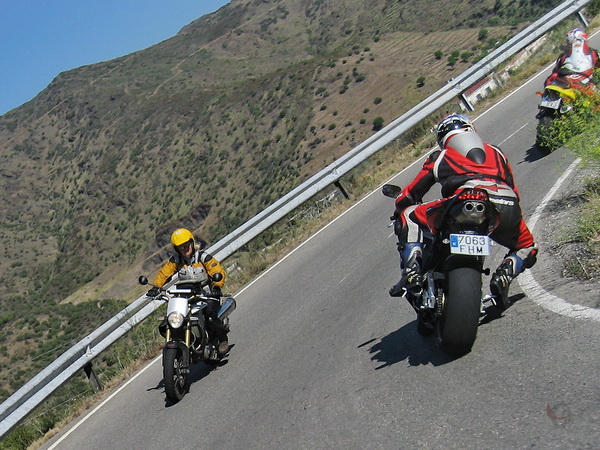
The Map
Finding good roads for motorcycle riders in Spain is easy: just look at the map and find crinkly roads!
The Meseta
In Spain, don't think that you should avoid flat roads at all cost: much of Spain is a flat high plain, the Meseta.
When you would avoid the Meseta, you would miss something essential of Spain, and you will miss how suddenly the landscape around you can change when you descend into a ravine with hairpin curves, without any warning.
The Ebro valley
The Ebro has flat country on both sides, and here again, there are spots you shouldn't miss.
Between Mequinenza and Caspe for instance, the hills are coloured in shades of yellow, orange, red and purple. The hills themselves are bare, and resemble what you see in Zion, Utah.
The Bardenas Reales, to the north of Tudela, is another region with strangely coloured and strangely shaped rocks.
Bare
In many areas of Spain, you see the bare rocks that form it. The north-west of the country is green (very green), but for the rest, much of it is arid land.
Within Europe, this is fairly unique. In many places, you would think to be in de south-west of the USA, or in northern Africa.
Inspiration
You can get inspiration for routes on the pages about some of the motorcycle travels in Spain we enjoyed.
A bit of History
Old
Spain has a long history of human inhabitants. Cadiz for instance, is the oldest continuously inhabited town of Europe. The famous paintings in Altamira are 17.000 years old
The Phoenicians and the Greeks did settle in Spain, and the Romans, from whom Spain got its current language.
Moors
But what sets Spain apart from other countries within Europe, is the inhabitance of the Moors: Berbers from North Africa, Muslims and Arabs.
They reigned in Spain from about 700 BC until about 1400; their territory first grew, and then shrunk until they only ruled Granada, and then lost everything.
Golden Ages
The Moors brought culture, irrigation, books, science, oranges, and many more beautiful things to Spain. Most of the time, they were tolerant to Jews and Catholics, and Spain thrived.
One of the most famous of them is Averroes (Ibn Rushd), who laid the base for freedom of thought and freedom of religion.
Reconquista
The Moors were defeted by the Catholics, during what is called the Reconquista.
However, Moorish influences can be seen in architecture until this day.
For a long time, Moorish architects were asked to build for the Catholic rulers. The resulting building style is called "Mudejar". The Giralda of Sevilla is an example of how Moorish buildings look.
What to see? Moorish architecture
Andalucia
The most spectacular part of Spain is, undoubtably, Andalucia.
Here, the most impressive Moorish buildings can be found.
Most famous is the Alhambra in Granada.
Cordoba with its Mezquita, and Sevilla with the Giralda are other examples of cities with many Moorish buildings.
But there are many more towns with an old Moorish inner centre, with ruins of Moorish castles, churches built on or around Moorish mezquita's, Moorish towers, etc.
Mudejar
You will find Mudejar architecture (simple ornaments in brick, with an almost "modern" look) everywhere. Some special places:
Tarazona, to the north-west of Zaragoza, is a delightful small town with a superb Ayuntamiento, and towers in Mudejar.
Teruel, to the north-west of Valencia, is another example, with beautiful towers in Mudejar.
Moorish castles
Many of Spains castles have a Moorish history as well. An impressive example is the castle of Gormaz.
What to see? Castles and Monasteries
25.000 castles
Spain has about 25.000 castles (of which many are in ruins). Many of those castles were built during the time of the Moors: the war between the Catholics and the Moors stretched out over a couple of hundred years, and after that war, it would still take a long time before castles were of no use anymore.
Today, they are of use again, for tourism (though only a few of them are "exploited".
Monasteries
Most monasteries are from after the Moors, though some of them are built on sites of a previous castle or mezquita from the Moors.
There are many monasteries in Spain; many of them still "working".
Many of them are worth a visit, because of their churches, courtyards, or religious art. One of the most spectacular is the Monastery of Guadeloupe. Another impressive monastery is the Real Monasterio de San Juan de la Peña.
Sleeping
Quite a few castles and monasteries are transformed into hotels, or offer you a place to sleep. Most of the castle-hotels are luxurious, while you may experience sobre monastery-life in some of the monasteries.
If you have the opportunity to sleep in such a place, do it; it will be a wonderfull experience (and your motorcycle will be very safe, for the night).
Suggestion: Andalucia
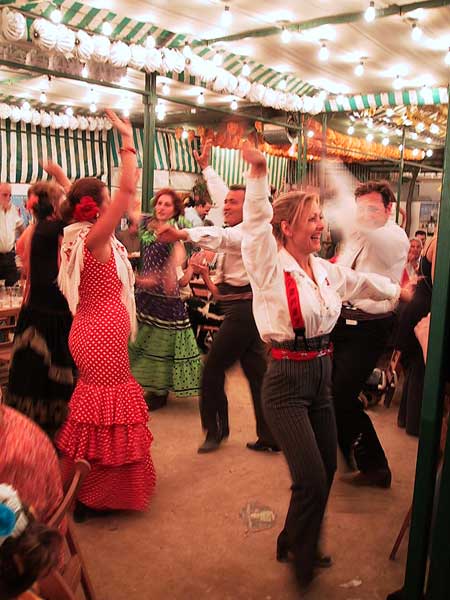
The maximum of Spanishness
In Andalucia, all prejudices about Spain seem to come true: there are feria where people dance in traditional costumes, while drinking and eating and enjoying life. They ride on proud horses (and sometimes use donkeys for transport), it's the home base for Flamenco, and it will be hard to find another place in Europe where people work to live as much as in Andalucia, where most things can be done "mañana", where the heart counts more than the brain.
These prejudices are both true and false. When you see wineyards and olive tree yards, man-made by thousands of stone walls to form terrasses on the slopes of mountains, you will realise that Andalucian people are capable to work very hard indeed (and do so).
But on the other hand, yes, people here know how to enjoy life, know what matters.
Motorcycle country
Andalucia is a superb motorcycle country: when you avoid high summer, temperature is ideal, and the Mediterranean Sea or Atlantic Ocean are close by.
The Sierra Nevada and Alpujarras, the mountains arouns Ronda, and the mountains above Sevilla offer mountain roads (and there are other mountain ranges as well).
Sevilla is a town like a fairy tale, and Cordoba and Granada offer superb Moorish architecture as well.
Sometimes it seems like there are more bars than people, and all of them have tapas, beer, wine, and refreshing non-alcoholic drinks.
You could go to the circuit of Jerez, see the cliff of Ronda, or wander through the desert of Cabo de Gata. You could spend weeks, months, years on motorcycle, and never be bored.
Valencia and inland
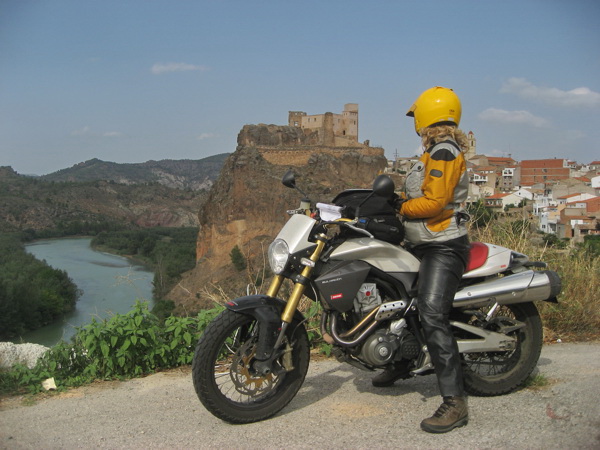
Valencia
Valencia is the third city of Spain, after Madrid and Barcelona. It's worth to explore (if only to fight the traffic in the inner city on motorcycle).
But the real secret od Valencia is the country behind.
Directly around Valencia are orchards with citrus trees, but a little bit further, there is a great motorcycle country.
Alcala del Jugar
One of the treasures is Alcala del Jugar. You reach it by riding on the plain of Castilla de la Mancha, and suddenly, the road descends, very steeply, into a ravine. All the way down, you will see a small town, in the curve of the river, with a castle on top.
Benageber
Another treasure is the "embalsa" of Benageber, lying very picturesque between steep mountain slopes, with a curious deserted factory on one of the slopes, and a monument telling that this embalsa is the achievement of "el Generalissimo".
Teruel
Or you could choose Teruel, a smaller town, with beautiful Mudejar towers, to be reached using the N330, offering superb motorcycle pleasure.
Wherever you go, there are mountains in different colours, stunning views, villages built against mountains, castles, gorges, and, remember we are in Spain, restaurants and small hostals.
Anywhere in Spain
In short
As long as you remember that Spain is more than its coasts (though some of its coasts offer great motorcycle roads), you can't go wrong: every region in Spain has its own beauty, its own specialties.
Even riding on the vast arid plains of Castilla La Mancha is a worthwhile experience: just as you are fantasizing about Don Quichotte going mad (and you can imagine vividly how anyone could get mad on those plains), you will descend into a beautifull gorge, cut out by a river, as patiently as the millions of stone walls have been built throughout the country, to use every piece of land for olive trees, grapes or oranges.
Warning
There is one warning though: you will get hooked!
Comments, Q & A, on a separate page




